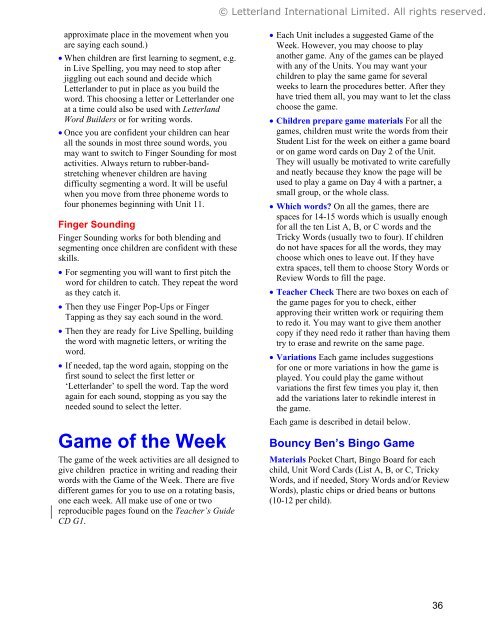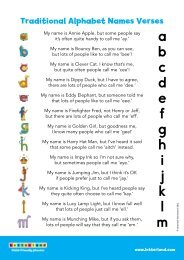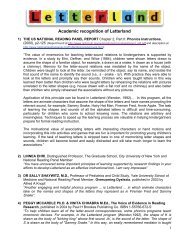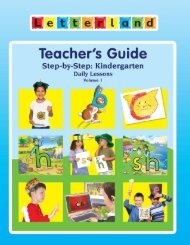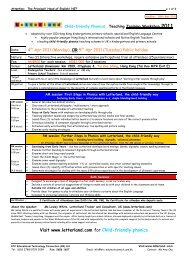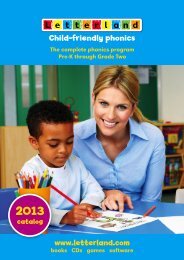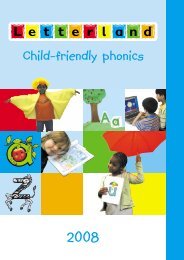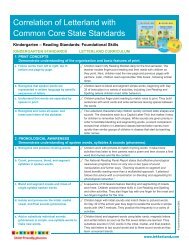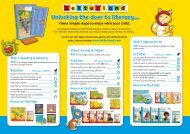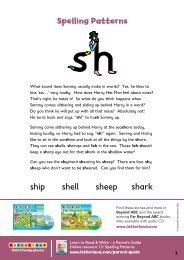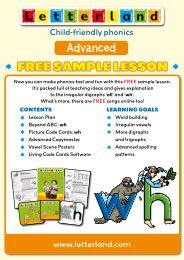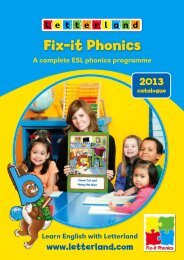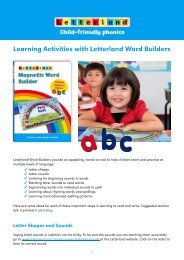Teacher's Guide - Letterland
Teacher's Guide - Letterland
Teacher's Guide - Letterland
Create successful ePaper yourself
Turn your PDF publications into a flip-book with our unique Google optimized e-Paper software.
© <strong>Letterland</strong> International Limited. All rights reserved.approximate place in the movement when youare saying each sound.)• When children are first learning to segment, e.g.in Live Spelling, you may need to stop afterjiggling out each sound and decide which<strong>Letterland</strong>er to put in place as you build theword. This choosing a letter or <strong>Letterland</strong>er oneat a time could also be used with <strong>Letterland</strong>Word Builders or for writing words.• Once you are confident your children can hearall the sounds in most three sound words, youmay want to switch to Finger Sounding for mostactivities. Always return to rubber-bandstretchingwhenever children are havingdifficulty segmenting a word. It will be usefulwhen you move from three phoneme words tofour phonemes beginning with Unit 11.Finger SoundingFinger Sounding works for both blending andsegmenting once children are confident with theseskills.• For segmenting you will want to first pitch theword for children to catch. They repeat the wordas they catch it.• Then they use Finger Pop-Ups or FingerTapping as they say each sound in the word.• Then they are ready for Live Spelling, buildingthe word with magnetic letters, or writing theword.• If needed, tap the word again, stopping on thefirst sound to select the first letter or‘<strong>Letterland</strong>er’ to spell the word. Tap the wordagain for each sound, stopping as you say theneeded sound to select the letter.Game of the WeekThe game of the week activities are all designed togive children practice in writing and reading theirwords with the Game of the Week. There are fivedifferent games for you to use on a rotating basis,one each week. All make use of one or tworeproducible pages found on the Teacher’s <strong>Guide</strong>CD G1.• Each Unit includes a suggested Game of theWeek. However, you may choose to playanother game. Any of the games can be playedwith any of the Units. You may want yourchildren to play the same game for severalweeks to learn the procedures better. After theyhave tried them all, you may want to let the classchoose the game.• Children prepare game materials For all thegames, children must write the words from theirStudent List for the week on either a game boardor on game word cards on Day 2 of the Unit.They will usually be motivated to write carefullyand neatly because they know the page will beused to play a game on Day 4 with a partner, asmall group, or the whole class.• Which words? On all the games, there arespaces for 14-15 words which is usually enoughfor all the ten List A, B, or C words and theTricky Words (usually two to four). If childrendo not have spaces for all the words, they maychoose which ones to leave out. If they haveextra spaces, tell them to choose Story Words orReview Words to fill the page.• Teacher Check There are two boxes on each ofthe game pages for you to check, eitherapproving their written work or requiring themto redo it. You may want to give them anothercopy if they need redo it rather than having themtry to erase and rewrite on the same page.• Variations Each game includes suggestionsfor one or more variations in how the game isplayed. You could play the game withoutvariations the first few times you play it, thenadd the variations later to rekindle interest inthe game.Each game is described in detail below.Bouncy Ben’s Bingo GameMaterials Pocket Chart, Bingo Board for eachchild, Unit Word Cards (List A, B, or C, TrickyWords, and if needed, Story Words and/or ReviewWords), plastic chips or dried beans or buttons(10-12 per child).36


